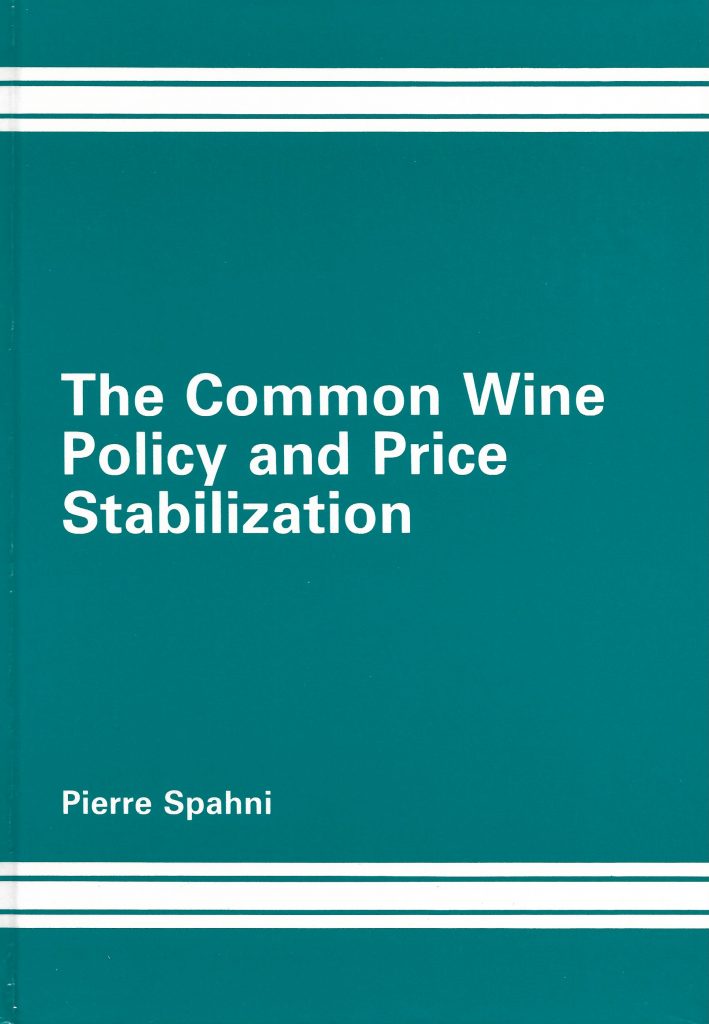THE COMMON WINE POLICY AND PRICE STABILIZATION
Pierre Spahni, Avebury (Gower Publishing Ltd), Aldershot UK
1988, 187 pages, ISBN 0-566-05400-0

***
An analysis of the EU’s common organisation of the market in wine, from its inception to the need for outright reform.
***
‘If one day there are wine futures, we’ll know where they come from.’
Concluding statement by Prof. Denis Lucey, Univ. of Cork,
on the day of submission of the eponymous
doctoral dissertation (1986).
***
List of tables
List of figures
List of abbreviations
Preface
Foreword
PART 1: THE COMMON WINE POLICY
1. Introduction
2. Background: French interventionism
The Wine Statute
AOC legislation
Postwar policies
3. Integration
The birth of the EC
The rise of the CAP
Regulation 24
Trade barriers
Production and marketing in Italy
Comparative advantage
France’s U-turn
Negotiating the CAP
Germany and Luxembourg
4. The Common Wine Policy
816, 817
Trade regime (border protection)
Prices and intervention (price support)
First review
A common structural policy
Market
Second review
PART 2: PRICE STABILIZATION
5. Introduction
6. Possible gains from partial price stabilization in wine
Risk and stabilization
Welfare gains
Stability in demand
7. Wine price changes
A basic model for price changes
Italy
France
8. Price support, stabilization and the Common Wine Policy
Direct price support (distillation)
Stabilization
References
Appendices
Al. Abstract of basic regulations
A2. Data, results and mathematical note
Index
*****
Tables
Classification of wines
Wine production
Acreage and farm structure
France in the 1930s
Winemaking in Italy
Italian co-operative wineries
Major price support arrangements
Community distillations (by Member State)
Community distillations (by measure)
FEOGA expenditure
Possible gains from price stabilization
Trends and variability in real prices
Average yields
Wine supply balances
Wholesaler’s hedge
Producer’s hedge
Data for Italy
Data for France
Results for Italy
Results for France
Figures
Production and consumption in France
French trade
Inventories in France
French producer prices
Production and consumption in Italy
Italian inventories and trade
Italian producer prices
Tariff and trade
Intervention
Common prices
Average producer prices
Supply, demand and trade for the Ten
Support and substitution
Transfer benefit to producers
Risk benefit to producers
Italian producer prices
French producer prices
The dynamics of price changes in Italy
The dynamics of price changes in France
Supply and demand for the Twelve
Restricted supply
“This study has been organised in two parts. The first dealing with prices and interventions provides a full description of the origins, formation, and evaluation of the Common Wine Policy. This part begins with a concise description of the policy. It then traces the historical roots of interventions in wine markets by explaining the steps taken by the French government to improve the quality of French wines and to provide a stable domestic wine market. The next step in the wine intervention process stems from the economic integration of Western Europe in the context of the EC and its Common Agricultural Policy. Of major importance discussed is the synchronisation of wine policies among France, Italy and Germany. This part concludes with a detailed explanation of the Common Wine Policy, including its regulations, ranging from 816/70 to the more recent 822/87. Analyzed are price supports, border protection, structural policy, and the policy reviews of 1976 and 1982.
The second part of the book is more analytical and evaluates the nature and desirability of wine price and income stabilization, causes of price instability, perverse effect of price support measures on the efficiency of the quality wine market, wine price behaviour, and policy proposals for market stabilization and reform. This part begins with a discussion drawing upon economic theory which evaluates the welfare gains from price stabilization in wine. Analyzed not only are producers’ gains but consumers’ as well, including the transfer of benefits. Considered next are the nature of price fluctuations and appropriate econometric models which could explain and predict those fluctuations. An empirical analysis of a suitable price stabilization model takes place based on French as well as ltalian experience. This part concludes with an evaluation of price support and price stabilization mechanisms in relation to the Common Wine Policy. Rather good suggestions are made as to how policies and institutions in other areas of agriculture can improve wine price and income stabilization.
This book can truly be considered a handbook on the Common Wine Policy. Its freshness of approach also makes it a guide for future wine stabilization in the EC. While both the policy and its stabilization mechanisms are sometimes thought to be too difficult to be addressed by the layman, this work proves this supposition to be wrong. The more technical aspects of the discussion can be skipped by the non-technical reader. The discussion on the stabilization of wine is simple and specific to the wine industry. It relies primarily on the characteristics of the product and of its price determination process. The evaluation of various complex policies and mechanisms is also conducted in a straightforward and clear manner.”
Excerpt from the preface by Prof. Walter C. Labys, West Virginia University.
***